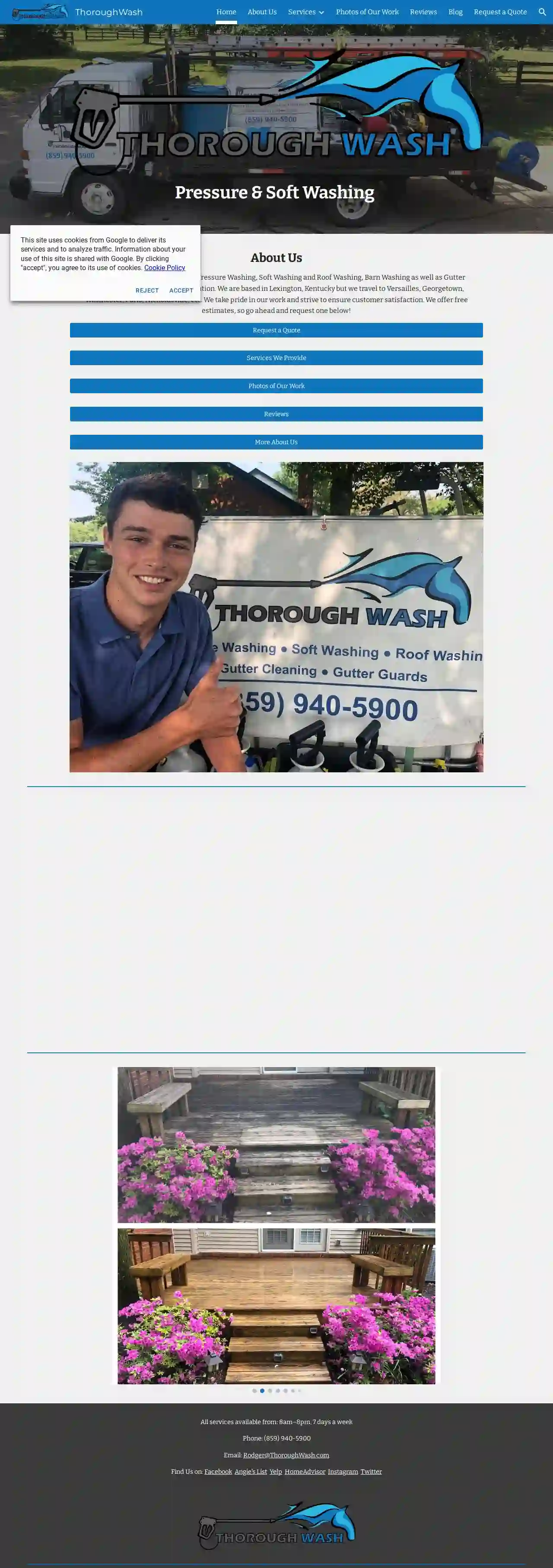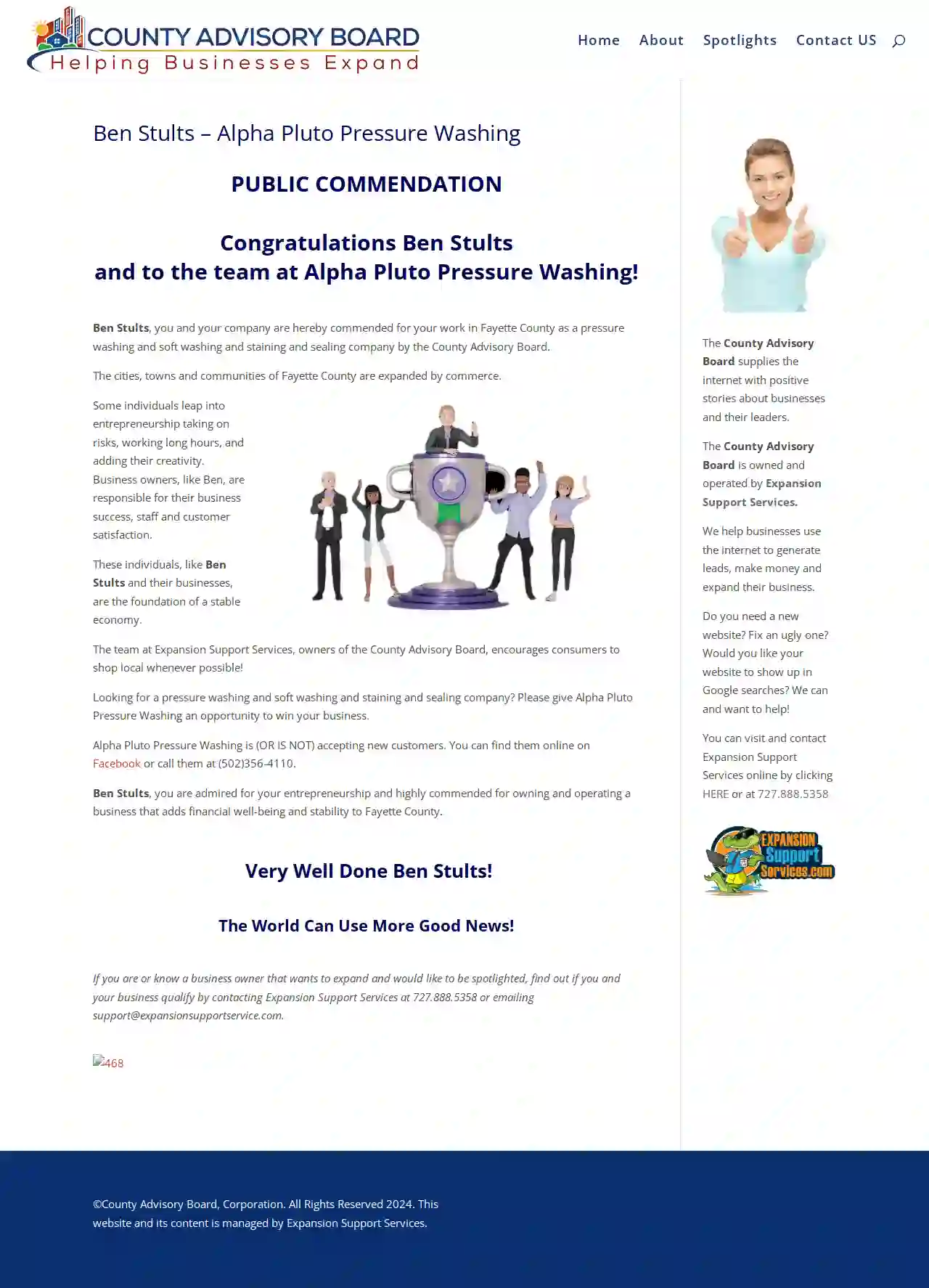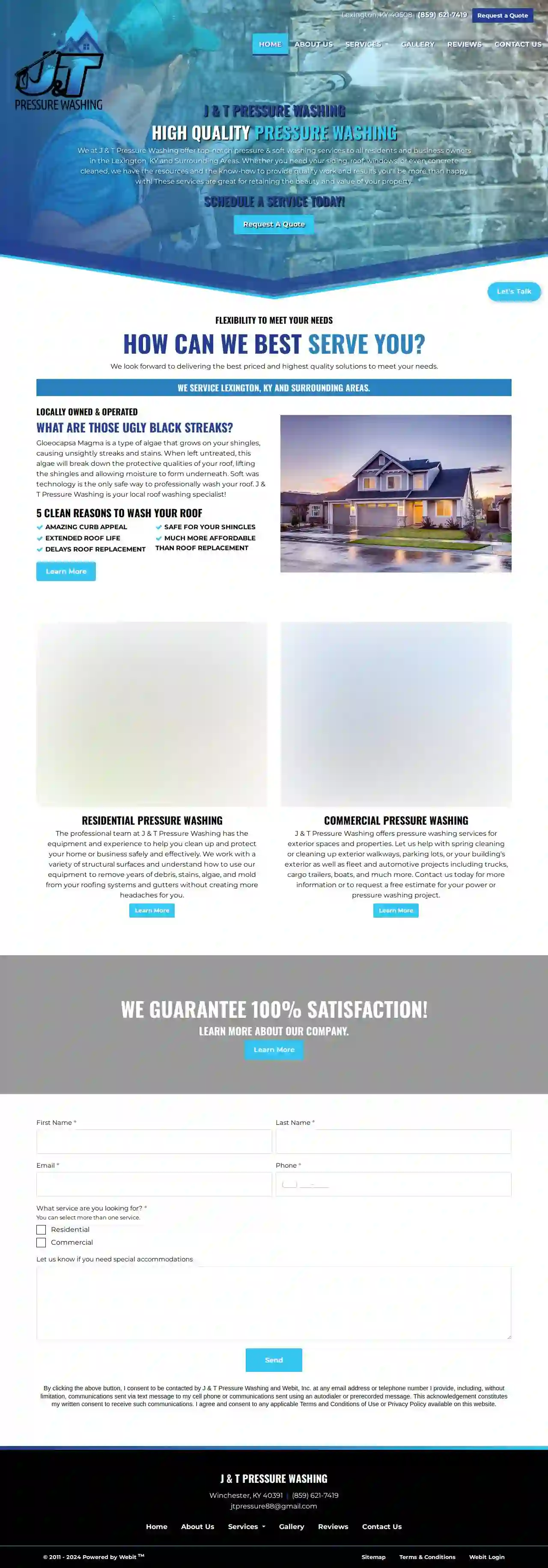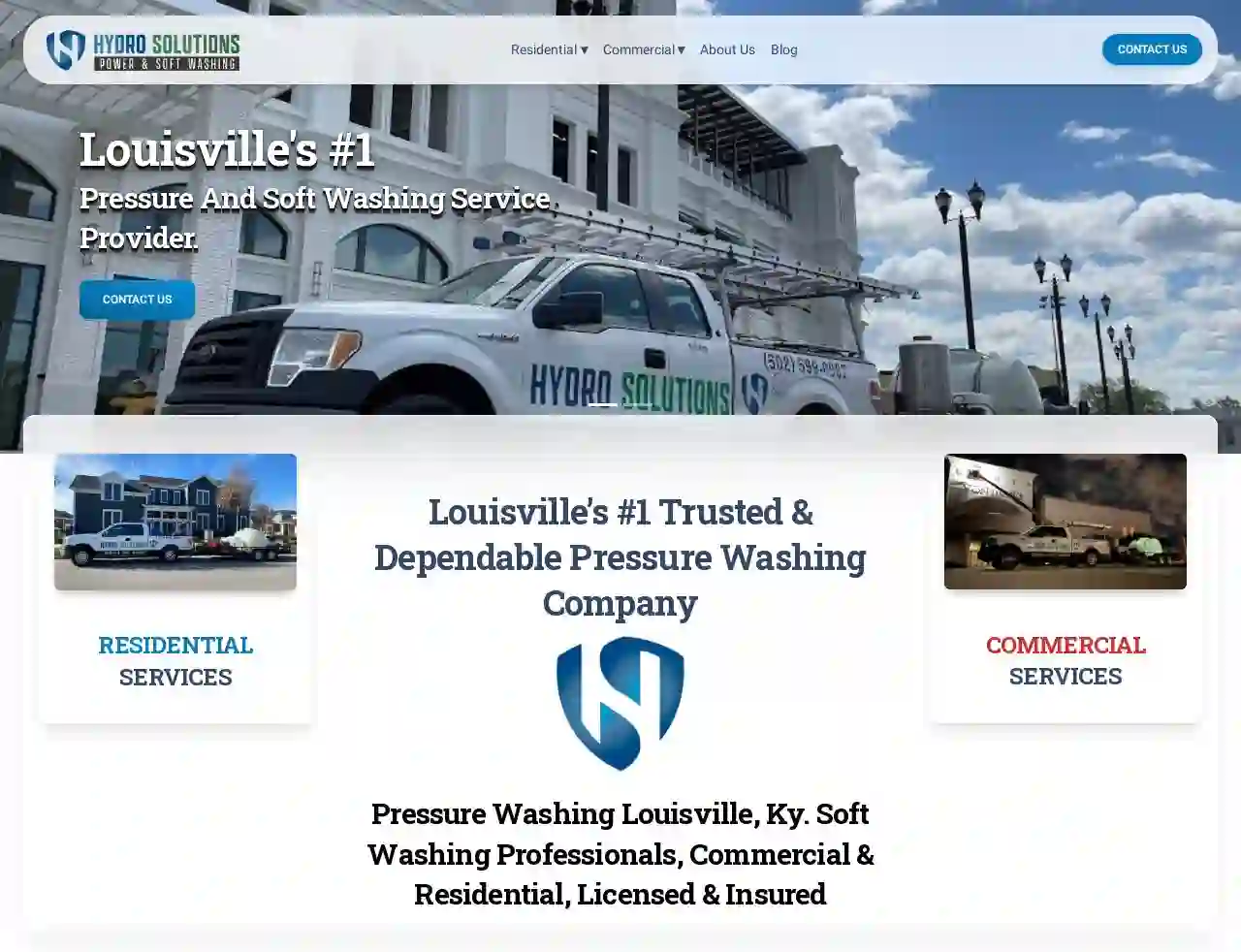Pressure Washing Corbin
Find top Pressure Washing in Corbin
Receive up to 3 Pressure Washing quotes for your project today! Compare profiles, reviews, accreditations, portfolio, etc... and choose the best offer.

Kentuckiana Pro Wash
513 reviewsElizabeth, IN, 11594 Majestic Way SE, 47117, USAt Kentuckiana Pro Wash, we're proud to be the top choice for quality pressure washing services in Louisville and the surrounding areas. Whether you need residential or commercial pressure washing services, we have the skills and expertise to get the job done right. Our team of highly trained technicians uses state-of-the-art equipment and the latest techniques to ensure your property receives the best possible care. We take pride in our work and always go the extra mile to exceed our customers' expectations.
- Services
- Why Us?
- Our Team
- Testimonials
- Gallery
Get Quote
ThoroughWash Pressure & Soft Washing
511 reviewsLexington, USThoroughWash Pressure & Soft Washing is a Lexington based business which was founded in 2020. Although the business is relatively new, all of our employees have multiple years of experience in the field. We are fully insured and our main goal is keeping our customers happy! We specialize in pressure washing, soft washing, roof washing, gutter cleaning and gutter guard installation. We offer prices which are hard to beat, quality that is unmatched, exceptional customer service and free estimates. So go ahead and request a quote today!
- Services
- Why Us?
- Gallery
Get Quote
SC Pro Wash
533 reviews101 S Lake Drive, Lexington, 29073, USSC Pro Wash offers a variety of pressure washing services and soft washing services for all types of clean up and curb appeal projects. We are a locally owned and operated pressure washing contractor with the equipment and expertise to wash and clean everything including driveways and walkways; concrete, brick, pavers; and all kinds of residential or commercial cleaning projects. Our team of cleaning technicians are dedicated to your complete satisfaction. So, if you're looking for a pressure washing contractor to provide quality, affordable exterior cleaning in the Lexington County and Richland County SC area, contact SC Pro Wash for a free estimate.
- Services
- Why Us?
- Our Team
- Testimonials
- Gallery
Get Quote
Alpha Pluto Pressure Washing
514 reviews123 Main St, Suite 100, Louisville, 40203, USThe County Advisory Board is a national organization helping business owners across the 3,143 US Counties have well-run, productive and profitable companies. It promotes involvement in local chambers, Little League, networking groups, business associations, fantasy football clubs, the Girl Scouts and every other sane opportunity for businesses, groups, associations and individuals. The County Advisory Board is not part of the any county government agency, your Chamber of Commerce, Better Business Bureau or other social organizations, but strongly suggests that all businesses join their local Chamber and/or other various business organizations.
- Services
- Why Us?
- Accreditations
- Our Team
- Testimonials
- Gallery
Get Quote
Hydrosphere Services
518 reviewsLexington, USAt Hydrosphere Services, our commitment to providing superior exterior pressure washing and environmental cleaning services is unmatched in Lexington,KY. We understand the transformative power of a clean exterior. Whether it’s your home, business, or industrial space, our professional pressure washing services are here to rejuvenate and restore surfaces to their pristine condition. A clean exterior enhances the curb appeal of your property but also protects it from the damaging effects of mold, mildew, algae, and other contaminants. Plus, a well maintained residence helps decrease unexpected expenditures. We strive to meet the needs of our customers and deliver cleaning solutions that protect, clean, and maintain their property. Our Residential Exterior Cleaning Services include brick and siding, roofs, gutters, driveways, walkways, decks and patios. We also offer an extensive menu of Commercial Pressure Washing Services because we know a clean and well-maintained commercial property leaves a lasting impression on visitors. Commercial pressure washing projects are big tasks and we are well equipped to handle the most complex projects with our experienced staff and state- of- the- art equipment. Our commercial pressure washing services include building washing, apartment complex pressure washing, window washing, restaurant and underbar cleaning, parking lots and garages. You can rely on Hydrosphere Services for the most professional residential or commercial pressure washing service in Lexington,KY. Contact us today for your free estimate.
- Services
- Why Us?
- Testimonials
- Gallery
Get Quote
Palmetto Wash Pros, LLC
5129 reviewsLexington, USPalmetto Wash Pros, LLC is a trusted restoration company that offers top-notch cleaning services to residential and commercial clients in and around Lexington, SC. With over thousands of satisfied customers, we have the skills, tools, and technical know-how to wash and clean your property like it's new. Our attention to detail is second to none, and you can count on us to be there for you for the long haul. We provide soft washing, pressure washing, restoration services, concrete cleaning, and roof cleaning solutions to bring out the best in your property.
- Services
- Why Us?
- Testimonials
- Gallery
Get Quote
J&T Pressure Washing LLC
Lexington, 40508, USJ & T Pressure Washing is a locally owned and operated pressure washing contractor serving Lexington, KY and the surrounding areas. We offer a variety of residential and commercial cleaning services, including siding, roof, and much more. Our team is dedicated to delivering professional cleaning and friendly customer care for an exceptional customer experience. We utilize soft wash technology, a low-pressure, solution-based cleaning method that is safe for your property. Whether you need your home or business refreshed, J & T Pressure Washing is your trusted partner for all your pressure washing needs. Contact us today for a free estimate and let us help you maintain the beauty and value of your property.
- Services
- Why Us?
- Gallery
Get Quote
Professional Pressure Washing
5522 reviews123 Main St, Suite 101, Columbia, 29020, USProfessional Lawn Care Pressure Washing is a privately owned, full service pressure washing company providing many of your power washing needs. We offer our services to commercial areas as well as residential. We provide a high - quality and prompt service that will make your home or office shine! We will work with you on a price that fits your budget, and our work is 100% guaranteed. Our trained specialists applies both the art and science of the industry and will safely and effectively clean your property.
- Services
- Why Us?
- Accreditations
- Our Team
- Testimonials
- Gallery
Get Quote
Hydro Solutions Power And Soft Washing LLC
4.9107 reviewsLouisville, USLouisville's #1 Pressure And Soft Washing Service Provider. Contact Us Louisville's #1 Choice for Commercial And Residential Pressure Washing Services! Contact Us Louisville’s #1 Trusted & Dependable Pressure Washing Company Pressure Washing Louisville, Ky. Soft Washing Professionals, Commercial & Residential, Licensed & Insured Nevertheless as an experienced Louisville Ky pressure washing company and soft washing service provider. Hydro Solutions will protect your home and property from damage while removing years of dirt and grime In Just One Visit. Experience first-rate service working with our team of experts. Satisfaction Guarantee Hydro Solutions Power And Soft Washing LLC is looking froward to offing you a Professional Pressure Washing Service. We service the Louisville, Ky area’s, and surrounding counties. Also Providing Power Washing Services to all of Southern Indiana as well. Pressure washing services in Louisville, Ky, and Southern Indiana are important. Plus for keeping the cleanliness and curb appeal of residential and commercial properties. The warm weather in these areas can contribute to the buildup of mold, mildew, and algae, mostly on siding, driveways, and decks. Power washing, or Soft Washing, can effectively remove these unsightly and potentially damaging organic substance’s. Soft Washing your surfaces to their original condition. In Louisville and Southern Indiana, pressure washing services can be provided for a wide range of clients. To homeowners clean their property’s curb appeal or businesses needing to maintain a clean exterior with a building soft wash. Hydro Solutions Power And Soft Washing power washing services often include cleaning of concrete, such as sidewalks and parking lots. Which can build up dirt, grime, oil, gum, and algae over time. Moreover, we as a power washing company specialize in services with a soft wash. Like roof cleaning, gutter brightening, house washing, concrete cleaning, and deck washing. We focus on customer satisfaction and job quality, Hydro Solutions Power And Soft Washing only use’s eco-friendly Soft Washing Solutions. Our strategies to suit any type of surfaces, guaranteeing a clean without causing damage to your commercial our residential property. Commercial or Residential soft washing we have you covered with a Satisfaction Guarantee Get A Free Quote Today
- Services
- Why Us?
- Gallery
Get Quote
Performance Pressure Washing
532 reviews11700 Hancock Trace Ct, Louisville, 40245, USPerformance Pressure Washing is a locally owned and operated business serving the Louisville, KY area. We specialize in a variety of pressure washing services, including residential and commercial power washing, freight truck power washing, deck cleaning, driveway sealing, and dining room/kitchen floor cleaning. We also offer restaurant and bar hood system cleaning. Our team of experts has years of experience in the industry and is dedicated to providing high-quality service at competitive prices. We understand the importance of maintaining the comfort and ambience of your deck, which is why we offer professional deck staining services. We use only the highest quality stains and sealants to protect your deck from the elements and enhance its beauty.
- Services
- Why Us?
- Accreditations
- Our Team
- Testimonials
- Gallery
Get Quote
Over 60,241+ Janitorial Companies on our directory
Our janitorial services operate in Corbin & surrounding areas!
CleaningMatch has curated and vetted the Best Cleaning Companies near Corbin. Find the most trustworthy contractor today.
Frequently Asked Questions About Pressure Washing
- Size of the Area: Larger areas generally cost more to pressure wash than smaller ones.
- Type of Surface: Different surfaces require different pressure levels and cleaning solutions, which can affect pricing.
- Condition of the Surface: Heavily soiled or stained surfaces may require more time and effort to clean, impacting cost.
- Accessibility: Difficult-to-reach areas may require specialized equipment and increase costs.
- Additional Services: Services like pre-treating stains, applying protective coatings, or mold removal may incur additional charges.
- Pressure Washing: For hard surfaces like concrete, brick, or decks, pressure washing can effectively remove mold and mildew. Use a cleaning solution containing bleach or mildewcide for optimal results.
- Soft Washing: For delicate surfaces like roofs or siding, soft washing is the preferred method for mold and mildew removal. Soft washing uses low-pressure water and specialized cleaning solutions to gently remove mold and mildew without damaging the surface.
- Prevention: After cleaning, take steps to prevent future mold and mildew growth by addressing moisture issues, such as fixing leaks, improving ventilation, and trimming vegetation that creates shade and traps moisture.
- Reputation and Reviews: Check online reviews and ask for referrals to gauge the company's reputation and customer satisfaction.
- Experience and Expertise: Look for a company with a proven track record and experience in pressure washing various surfaces.
- Licensing and Insurance: Ensure the company is licensed and insured to protect you from liability.
- Equipment and Techniques: Inquire about the company's equipment and techniques to ensure they use appropriate pressure levels and cleaning solutions.
- Quotes and Pricing: Obtain detailed quotes that outline all services and costs.
- Professionalism and Communication: Choose a company that is responsive, communicative, and professional.
- Pressure Washing: Suitable for hard surfaces like concrete, brick, stone, and decks that can withstand high pressure. Effective for removing stubborn dirt, grime, and stains.
- Soft Washing: Best for delicate surfaces like roofs, siding, painted surfaces, and wood fences that may be damaged by high pressure. Effective for removing mold, mildew, algae, and other contaminants without causing harm.
How much does pressure washing cost?
To get accurate pricing, request quotes from multiple pressure washing companies. Provide details about the size and type of surface, its condition, and any additional services you require.
Can pressure washing remove mold and mildew?
If you have extensive or persistent mold and mildew problems, consult with a professional pressure washing company or a mold remediation specialist.
What should I look for in a pressure washing company?
A reputable pressure washing company will prioritize safety, use appropriate cleaning methods, and provide excellent customer service.
How do I know if I need pressure washing or soft washing?
If you're unsure which method is best for your surfaces, consult with a professional pressure washing company. They can assess your needs and recommend the most appropriate cleaning method.
How much does pressure washing cost?
- Size of the Area: Larger areas generally cost more to pressure wash than smaller ones.
- Type of Surface: Different surfaces require different pressure levels and cleaning solutions, which can affect pricing.
- Condition of the Surface: Heavily soiled or stained surfaces may require more time and effort to clean, impacting cost.
- Accessibility: Difficult-to-reach areas may require specialized equipment and increase costs.
- Additional Services: Services like pre-treating stains, applying protective coatings, or mold removal may incur additional charges.
To get accurate pricing, request quotes from multiple pressure washing companies. Provide details about the size and type of surface, its condition, and any additional services you require.
Can pressure washing remove mold and mildew?
- Pressure Washing: For hard surfaces like concrete, brick, or decks, pressure washing can effectively remove mold and mildew. Use a cleaning solution containing bleach or mildewcide for optimal results.
- Soft Washing: For delicate surfaces like roofs or siding, soft washing is the preferred method for mold and mildew removal. Soft washing uses low-pressure water and specialized cleaning solutions to gently remove mold and mildew without damaging the surface.
- Prevention: After cleaning, take steps to prevent future mold and mildew growth by addressing moisture issues, such as fixing leaks, improving ventilation, and trimming vegetation that creates shade and traps moisture.
If you have extensive or persistent mold and mildew problems, consult with a professional pressure washing company or a mold remediation specialist.
What should I look for in a pressure washing company?
- Reputation and Reviews: Check online reviews and ask for referrals to gauge the company's reputation and customer satisfaction.
- Experience and Expertise: Look for a company with a proven track record and experience in pressure washing various surfaces.
- Licensing and Insurance: Ensure the company is licensed and insured to protect you from liability.
- Equipment and Techniques: Inquire about the company's equipment and techniques to ensure they use appropriate pressure levels and cleaning solutions.
- Quotes and Pricing: Obtain detailed quotes that outline all services and costs.
- Professionalism and Communication: Choose a company that is responsive, communicative, and professional.
A reputable pressure washing company will prioritize safety, use appropriate cleaning methods, and provide excellent customer service.
How do I know if I need pressure washing or soft washing?
- Pressure Washing: Suitable for hard surfaces like concrete, brick, stone, and decks that can withstand high pressure. Effective for removing stubborn dirt, grime, and stains.
- Soft Washing: Best for delicate surfaces like roofs, siding, painted surfaces, and wood fences that may be damaged by high pressure. Effective for removing mold, mildew, algae, and other contaminants without causing harm.
If you're unsure which method is best for your surfaces, consult with a professional pressure washing company. They can assess your needs and recommend the most appropriate cleaning method.